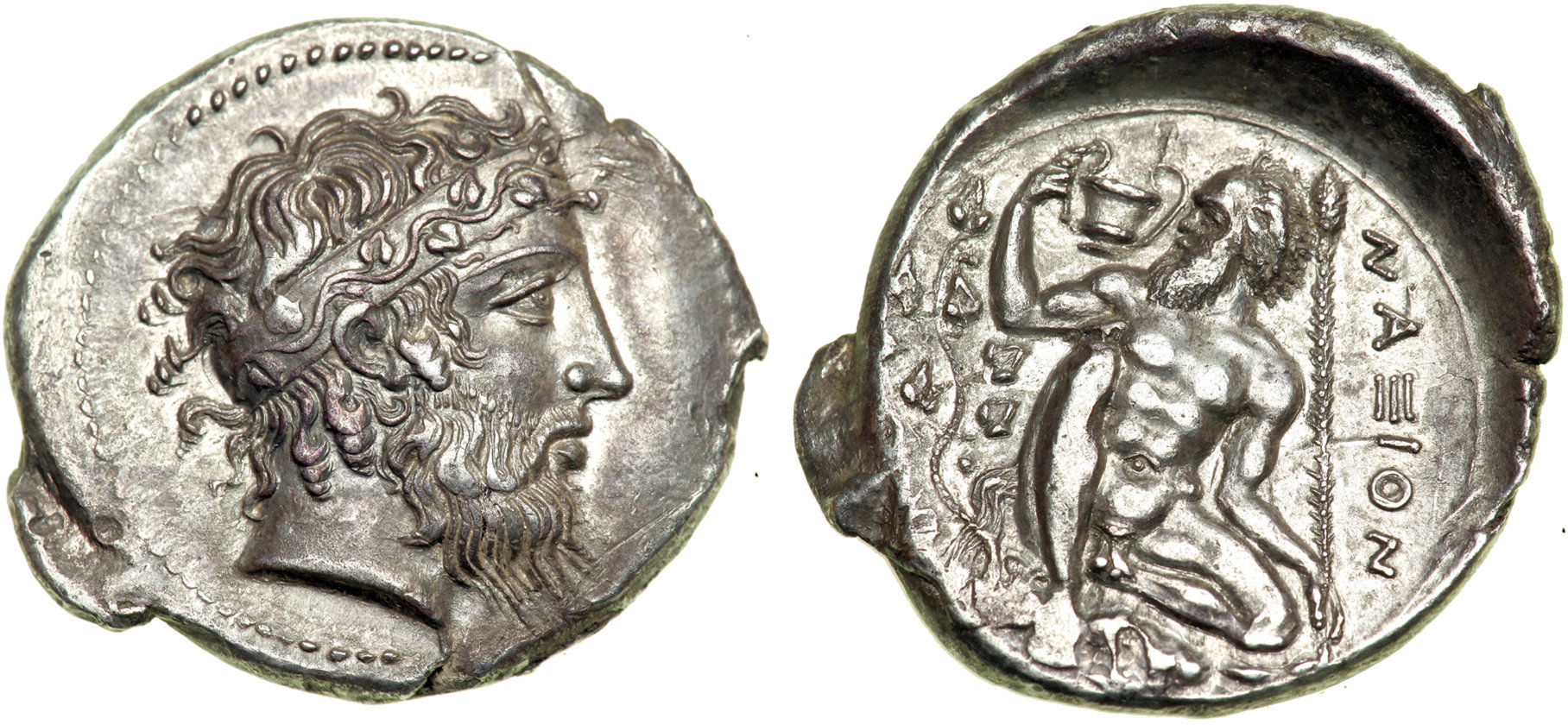Naxus, silver, tetradrachms (Dionysus/Silenus) (425-425 BCE)
From SILVER
425 BCE - 425 BCE Silver 324 kg
Description
| ObverseInscription or printing placed on the obverse.: | Head right of Dionysios, hair bound with taenia ornamented with ivy |
| ReverseInscription or printing placed on the reverse.: | NAΞION (Greek).Silenos squatting, head left, holding kantharos and thyrsos, to left, ivy plant |
Mint and issuing power
| MintIdentifies the place of manufacture or issue of a numismatic object.: | Naxus | Ancient regionAncient region.: | Sicily | Modern countryModern country: Italy | AuthorityIdentifies the issuing power. The authority can be "pretended" when the name or the portrait of X is on the coin but he/she was not the issuing power. It can also be "uncertain" when there is no mention of X on the coin but he/she was the issuing power according to the historical sources: |
Chronology
| FromIdentifies the initial date in a range assigned in a numismatic context. | 425 BCE | toIdentifies the final date in a range assigned in a numismatic context.. | 425 BCE | PeriodTime period of the numismatic object.: Classical 480-323 BC |
Physical description
| MetalThe physical material (usually metal) from which an object is made.: | Silver |
Median weightMedian of the weights of numismatic objects (in grams). in grams | 17.05 | DenominationTerm indicating the value of a numismatic object. Examples: tetradrachm, chalkous, denarius.: | tetradrachm |
StandardStandard.: |
Image

AC 80 - Naxus, silver, tetradrachms (425-425 BCE).jpg [1]
References
| Die study referencePublication of the study: | Cahn 19441Cahn 1944, p. 130-133, n° 99-103. | ||
| Coin series referenceReference to coin series study: | Sear I2Sear I, n° 875, RQEMAC3RQEMAC, n° 81 | ||
Obverse dies distribution
| FrequencyFrequency of specimen in distribution. ᵖ | Number of obversesNumber of obverse dies. ᵖ (o) | % (o) | Number of coinsNumber of coins. (n) | % (n) | Die nameName(s) of the die(s). |
| 56 | 1 | 100 | 56 | 109.8 | 66 |
| Total | 1 of 1 | 100 | 56 of 51 | 109.8 |
Reverse dies distribution
no distribution is available
Quantification
| Number of obversesNumber of obverse dies. ᵖ (o) | 1 | Number of singletons (o1)The number of singleton coins. ᵖ | |
| Number of reverse diesNumber of reverse dies. (r) | 1 | Number of coinsNumber of coins. (n) | 51 |
| Coins per obverse dieNumber of coins per obverse die. (n/o) | 51 | Coins per reverse dieNumber of coins per reverse die. (n/r) | 51 |
| Reverse per obverse ratioRatio of obverse dies divided by reverse dies. (r/o) | 1 | Percentage of singletons (o1)number of coins (n) divided by the number of singletons (o1) ᵖ | % |
| Original number of dies (O) (Carter 1983 formula)The estimation of the number of coins according to Carter 1983 ᵖ | 0.95 | Coins struck if 20,000 as average productivity per dieCoins made if the average productivity for obverses (according to Carter) is 20,000. ᵖ | 19,000 |
| Original number of dies (O) (Esty 2011 formula)The estimation of the number of coins according to the singleton formula in Esty 2011 ᵖ (O) | 1.02 | Survival rate if 20,000 as average productivity per dieSurvival rate if average productivity is 20,000. ᵖ | 0.00268 |
| Coverage (o = % of O) (Esty 1984 formula)Esty 1984 - coverage (% of O) ᵖ (o = % of O) | % | Die productivity if survival rate 1/2,000Average productivity if survival rate is 1/2,000. ᵖ | 107,368.42 |
| Weight of silver (in kg) if 20,000 coins per die (O = Carter formula)Carter 1983 * Median weight * 20000 (*10 if gold or electrum) ᵖ | 324 kg <br /> 324 kg | Die productivity if survival rate 1/5,000Average productivity if survival rate is 1/5,000. ᵖ | 268,421.05 |
Remarks
Most likely one single workstation
References
- ^ Cahn, Herbert A. (1944), Die Münzen der sizilischen Stadt Naxos. Ein Beitrag zur Kunstgeschichte des griechischen Westens, Basel, 168 p., XII pl.
- ^ Sear, David R. (1978), Greek coins and their values. Vol. I, Europe, London, xl, 316 p.
- ^ Callataÿ, François de (2003), Recueil quantitatif des émissions monétaires archaïques et classiques, Numismatique Romaine, Wetteren, VII + 267 p.